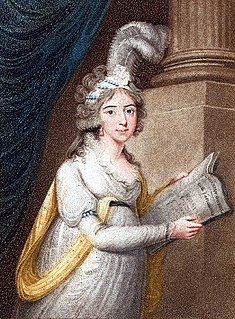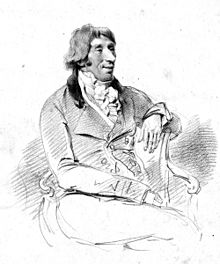
Alessandro nelle Indie is an opera seria in two acts by Giovanni Pacini to a libretto by Andrea Leone Tottola and Giovanni Schmidt, based on Alessandro nell'Indie by Pietro Metastasio. It was premiered at the Teatro di San Carlo in Naples on 29 September 1824, and had a total of 38 performances in its first season.

La buona figliuola, or La Cecchina, is an opera buffa in three acts by Niccolò Piccinni. The libretto, by Carlo Goldoni, is based on Samuel Richardson's novel Pamela; or, Virtue Rewarded. This was Piccinni's most successful Italian opera. There was a sequel entitled La buona figliuola maritata (1761) by the same composer and librettist. La buona figliuola supposta vedova by Gaetano Latilla followed in 1766.

Medonte, re di Epiro is an opera seria in three acts by Giuseppe Sarti. The libretto was by Giovanni de Gamerra for Felice Alessandri's opera Medonte, re d'Epiro (1774) and was later set by several other composers.

Calliroe is an opera by Antonio Sacchini, set to a libretto by Mattia Verazi. It was first performed in Ludwigsburg on 11 February 1770 and the ballets were set by French choreographer Louis Dauvigny.

Creso ('Croesus') is an opera seria in 3 acts with music by Antonio Sacchini, set to an Italian libretto by Gioacchino Pizzi after Book I of the Histories by Herodotos. The opera was first performed on 4 November 1765 at the Teatro San Carlo in Naples. The libretto was a popular one that had been first set by Niccolò Jommelli.

BrigidaGiorgi, better known by her husband's surname and her stage-name, as Brigida Banti (1757–1806) was an Italian soprano.

Giuseppe Francesco Bianchi was an Italian opera composer. Born at Cremona, Lombardy, he studied with Pasquale Cafaro and Niccolò Jommelli, and worked mainly in London, Paris and in all the major Italian operatic centres of Venice, Naples, Rome, Milan, Turin, Florence.
La Lodoiska is an opera in three acts by Simon Mayr to an Italian libretto by Francesco Gonella De Ferrari. It was Mayr's second opera and premiered at La Fenice in Venice on 26 January 1796.
Giuseppe de Majo was an Italian composer and organist. He was the father of the composer Gian Francesco de Majo. His compositional output consists of 10 operas, an oratorio, a concerto for 2 violins, and a considerable amount of sacred music.
Conchita is an opera in four acts and six scenes by composer Riccardo Zandonai. The work uses an Italian language libretto by Maurizio Vaucaire and Carlo Zangarini which is based on Pierre Louÿs's 1898 novel La Femme et le pantin. The work premièred in Milan at the Teatro dal Verme on 14 October 1911 with soprano Tarquinia Tarquini, who later married Zandonai in 1917, in the title role. Her portrayal was lauded by critics and she went on to perform Conchita at the Royal Opera, London (1912), the Cort Theatre in San Francisco (1912), the Philarmonic Auditorium in Hollywood (1912), the Heilig Theatre in Portland (1912), the Metropolitan Opera House in Philadelphia (1912), the Chicago Grand Opera Company (1913), the Metropolitan Opera in New York City (1913), and the Teatro di San Carlo in Naples (1913).

Siroe, or Siroe re di Persia, is an opera seria in three acts by Johann Adolph Hasse. The libretto was by Metastasio. As with many of the latter's libretti, Siroe was also set by Hasse's contemporaries, for example Vinci, Vivaldi and Handel.

Calto is an opera seria in three acts by Francesco Bianchi. The libretto was by Giuseppe Maria Foppa, after the 'celtic' poetry of Ossian. The opera was first performed at the Teatro San Benedetto in Venice on 23 January 1788.

La villanella rapita is an opera giocosa in two acts by Francesco Bianchi. The libretto was by Giovanni Bertati.

Castore e Polluce is an opera seria by Francesco Bianchi. The libretto was one translated by Carlo Innocenzo Frugoni, from Pierre-Joseph Bernard's French text for Rameau's Castor et Pollux.

Arbace is an opera seria in three acts by Francesco Bianchi. The libretto was by Gaetano Sertor.

Seleuco, re di Siria is an opera seria in three acts by Francesco Bianchi. The libretto was by Mattia Botturini, after Antioco by Apostolo Zeno and Pietro Pariati, a libretto first set by Francesco Gasparini in 1705.

La morte di Cesare is an opera seria in three acts by Francesco Bianchi. The libretto was by Gaetano Sertor, after Shakespeare's play Julius Caesar.

Alonso e Cora is an opera seria in three acts by Francesco Bianchi. The libretto was by Giuseppe Foppa, after Ferdinando Moretti's Idalide, o sia La vergine del sole, as used by Giuseppe Sarti in Milan in 1783. The original source of this text was in turn Jean François Marmontel's Les Incas, ou La destruction de l'empire du Pérou (1777).
Mattia Verazi was an Italian librettist primarily active at the court of Charles Theodore in Mannheim. He became known as the leader of a group of librettists who challenged the conventions of opera seria in the mid-18th century and was a long-time collaborator of composer Niccolò Jommelli. He also produced the libretti for Salieri's Europa riconosciuta, Sacchini's Calliroe, and J. C. Bach's Temistocle







